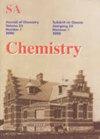Adsorption-Kinetic Studies of Mordant Exhaust Dyeing of Cotton and Silk Fabrics with Dye Extract of M. lucida Plant Species
IF 1
4区 化学
Q4 CHEMISTRY, MULTIDISCIPLINARY
South African Journal of Chemistry-Suid-Afrikaanse Tydskrif Vir Chemie
Pub Date : 2021-01-01
DOI:10.17159/0379-4350/2021/v75a16
引用次数: 0
Abstract
ABSTRACT The kinetics and adsorption isotherms of the extremely slow traditional natural exhaust dyeing that takes many hours or days have been studied purposely to find means of improving the process. The dyeing of cotton and silk fabrics using dye extract of M. lucida at 50 °C were elucidated with graphs to predict the reaction orders and identify the appropriate adsorption isotherm model(s). Since the dye is UV active, changes in UV absorbance were used in place of changes in concentrations. The simultaneous and post mordanting methods followed pseudo-second-order reactions, hence chemisorption. However, mordant application to the dyed fabrics during post mordant followed a pseudo-first-order model, largely physisorption. Dyeing has followed Langmuir and Freundlich isotherm models with linear correlation r2 ranging between 1 and 0.998. From the Freundlich model and values of Langmuir constant RL (0.9307 to 1.0), the process is homogeneous, forming a favourable and linear monolayer. Accordingly, the dyeing speed can be improved by increasing the concentration of dye liquor. Additionally, according to the Freundlich model, higher dye intensity on fabrics is recorded in post mordanting. Keywords: adsorption isotherms, equilibrium, exhaust dyeing, mordant, rate law植物染料提取物对棉丝织物媒染剂废气染色的吸附动力学研究
摘要:本文研究了传统自然废气染色的动力学和吸附等温线,以寻找改进该工艺的方法。用图表分析了露丝酵母染料浸出物在50℃下对棉丝织物的染色,预测了反应顺序,并确定了合适的吸附等温线模型。由于染料具有紫外线活性,因此使用紫外线吸收的变化来代替浓度的变化。同时和后处理方法遵循伪二级反应,因此是化学吸附。然而,媒染剂在染色织物上的后媒染剂应用遵循伪一阶模型,主要是物理吸附。染色遵循Langmuir和Freundlich等温线模型,线性相关r2在1和0.998之间。从Freundlich模型和Langmuir常数RL(0.9307 ~ 1.0)的值来看,该过程是均匀的,形成了一个有利的线性单层。因此,可以通过提高染液浓度来提高染色速度。此外,根据Freundlich模型,织物上较高的染料强度记录在媒染剂后。关键词:吸附等温线,平衡,排气染色,媒染剂,速率规律
本文章由计算机程序翻译,如有差异,请以英文原文为准。
求助全文
约1分钟内获得全文
求助全文
来源期刊
CiteScore
3.10
自引率
0.00%
发文量
6
审稿时长
>12 weeks
期刊介绍:
Original work in all branches of chemistry is published in the South African Journal of Chemistry. Contributions in English may take the form of papers, short communications, or critical reviews.

 求助内容:
求助内容: 应助结果提醒方式:
应助结果提醒方式:


